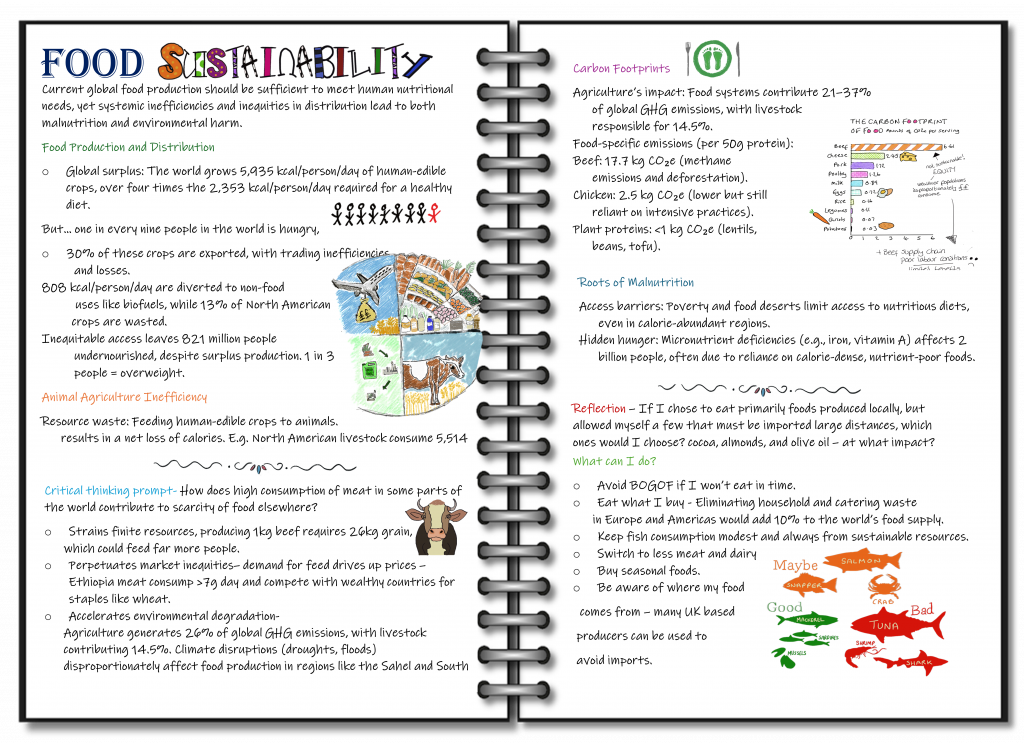April 14, 2025, by Laura Nicholson
Visual journals and sustainability; fostering critical thinking and personal connection
Visual journals
Visual journalling is a learning strategy that promotes critical thinking by encouraging students to engage with new concepts in experimental ways. It combines imagery and text, allowing students to reflect on their learning using multiple mediums, which in turn enhances the learning process. The approach aligns well with pedagogical principles of engagement, supporting students to be actively involved in the learning process (Hanzalik, 2019; Hooks, 2010). By integrating visual journals into sustainability education, students connect theoretical concepts with everyday practical examples and actions, thus fostering a more holistic understanding of sustainability.
Creativity
Rivas (2024) highlights the effectiveness of journal-based learning in developing sustainability awareness and new habits among students in higher education. Journalling triggers reflective practice as students connect and develop their ideas on sustainability through the process of being creatively involved in the search for solutions. These creative practices inspire social consciousness and action, perfectly demonstrating how art can be a medium for sustainability education and advocacy (Visual Artists Ireland, 2024).
Reflection
Visual journals promote reflective practices such as observation, synthesis, and evaluation. By jotting down their thoughts using text and imagery, students engage deeply with abstract ideas and personalise theoretical concepts (Loerts & Belcher, 2019; Hyland-Russell, 2013). By utilising creative expression, students will need to take time to reflect on what images are being conjured up in their minds as they relate themselves to the concepts being learnt. This in turn helps students to align themselves with their position on environmental and social issues. It isn’t necessary to be of artist standard; doodles and basic sketches are all reflections of what we are thinking.
Critical thinking
As the students map out their reflections on paper, they will begin to make connections between sustainability challenges. This visual approach promotes action-orientated thinking, encouraging the exploration of potential solutions to address these interconnected challenges. Doodles, sketches, graphs, and mind maps help students synthesise information creatively and will promote deeper levels of engagement with the content.
Empowering student voice with visual journals
Visual journals provide a space for students to express their perspectives on sustainability to build confidence around the subject area. The reflection required to transform their thoughts into visual images helps students make connections regarding what they can do on a personal level. As they sketch their thoughts, they have the time to reflect on how they themselves can influence change through their participation in broader public forums, such as discussions, advocacy, or environmental projects.

No need to be an artist; doodles and sketches are perfectly fine for conveying thoughts and adding meaning to concepts
Reflective prompts
To provide additional support, prompts can be provided for the students. They should be designed to encourage students to think about their role in creating a sustainable future. They could include prompts such as “How do your daily choices impact local ecosystems?” or “Reflect on how social issues like inequality affect environmental sustainability.”
Experiential learning
Visual journalling is grounded in Kolb’s (1984) Experiential Learning Theory. Kolb describes learning as a cyclical process comprising concrete experience, reflective observation, abstract conceptualisation, and active experimentation. By engaging in reflective observation through visual expression. Students then critically analyse their experiences and begin to form abstract concepts that connect personal insights to broader theoretical frameworks. This process not only deepens understanding but also fosters the integration of theory and practice. In turn, students are empowered to actively experiment with new ideas in real-world contexts.
Accessibility and visual journals
Variation in assessment types is essential for engagement, and accessibility means providing all activities with adjustments to ensure inclusivity. Visual journalling can pose challenges for visually impaired students due to its reliance on visual elements. However, adjustments like audio descriptions, collaborative projects, or AI-generated images can ensure inclusivity. It also encourages accessibility practices, such as avoiding reliance on colour alone and using patterns, shapes, labels, and ALT-text. While often focused on visual impairments, accessibility should also address cognitive ability, dexterity, and language differences. Visual journalling is a versatile communication tool suitable for diverse audiences.
Multimedia integration and AI
E-portfolios like Mahara support visual journalling by allowing students to upload images, videos, and sketches. AI tools such as DALL-E can further assist students who struggle with visual expression by generating images based on prompts. For example, a student can describe the concept of renewable energy, and DALL-E will create an image to represent this. This process helps students effectively convey their thoughts and enhances engagement with sustainability topics through visual representation.
References
Hanzalik, K. (2019) Creating Art in a Critical Research and Writing Course. Double Helix, Vol 7. DOI: I: 10.37514/DBH-J.2019.7.1.05
Hooks, B. (2010). Teaching critical thinking: Practical wisdom. New York: Routledge.
Hyland-Russell, T. (2014) ‘‘I will write to you with my eyes’: reflective
text and image journals in the undergraduate classroom’, Studies in Higher Education, 39:6,
1055-1069, DOI: 10.1080/03075079.2013.777403
Loerts, T., & Belcher, C. (2019). Developing visual literacy competencies while learning course content through visual journaling: teacher candidate perspectives. Journal of Visual Literacy, 38(1–2), 46–65. DOI:10.1080/1051144X.2018.1564603
Malinikart. (2023) The carbon footprint of food. Available at: https://www.alamy.com/carbon-footprint-of-food-infographic-greenhouse-gases-contribution-in-diet-plant-based-diet-environmental-and-ecology-concept-true-data-flat-vec-image504034281.html (Last accessed 11/04/2025)
Notaras, M. (2010) Scaling up Sustainable Seafood. Available at: https://ourworld.unu.edu/en/scaling-up-sustainable-seafood (Last accessed 10/04/2025)
Rivas, A. (2024) Exploring My Sustainable Footprint: An Innovative Journal-Based Method for Developing Sustainability Awareness and Habits. International Conference on Engineering and Product Design Education. DOI:10.35199/EPDE.2024.35
Visual Artists Ireland. (2024) Sustainable Art Practices: Some Thoughts for Visual Artists. Available at: https://visualartists.ie/how-to-manual/sustainable-art-practices-some-thoughts-for-visual-artists/ (Last accessed 11/04/2025)
No comments yet, fill out a comment to be the first

Leave a Reply